Bocaue, Bulacan
| Bocaue Bokawe | ||
|---|---|---|
| Municipality | ||
| Municipality of Bocaue | ||
|
Bocaue Municipal Hall | ||
| ||
| Nickname(s): Fireworks Capital of the Philippines | ||
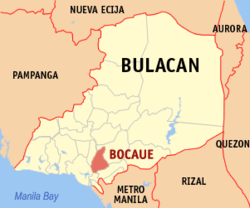 Map of Bulacan with Bocaue highlighted | ||
.svg.png) Bocaue Location within the Philippines | ||
| Coordinates: 14°48′N 120°56′E / 14.8°N 120.93°ECoordinates: 14°48′N 120°56′E / 14.8°N 120.93°E | ||
| Country |
| |
| Region | Central Luzon (Region III) | |
| Province | Bulacan | |
| District | 2nd District | |
| Founded |
1582 (as a barrio of Meycauayan) | |
| Chartered |
April 11, 1606 (as an independent town) [1] | |
| Founded by |
| |
| Barangays | 19 (see Barangays) | |
| Government [2] | ||
| • Type | Sangguniang Bayan | |
| • Mayor | Eleanor J. Villanueva-Tugna | |
| • Vice Mayor | Aldrin B. Sta. Ana | |
| • Electorate | 58,181 voters (2016) | |
| Area [3] | ||
| • Total | 31.87 km2 (12.31 sq mi) | |
| Elevation | 9 m (30 ft) | |
| Highest elevation | 30 m (100 ft) | |
| Population (2015 census)[4] | ||
| • Total | 119,675 | |
| • Density | 3,800/km2 (9,700/sq mi) | |
| Demonym(s) |
| |
| Time zone | UTC+8 (PST) | |
| ZIP code | 3018 | |
| PSGC | 031404000 | |
| IDD : area code | +63 (0)44 | |
| Climate type | Tropical monsoon climate | |
| Income class | 1st municipal income class | |
| Poverty rate |
| |
| • Revenue (2017) |
| |
| • Expenses (2017) |
| |
| • Total Assets (2017) |
| |
| Electricity | Manila Electric Company | |
| • Consumption | 109.20 million kWh (2003) | |
| Native languages | Tagalog | |
| Website |
www | |
Bocaue, officially the Municipality of Bocaue, (Tagalog: Bayan ng Bocaue), is a 1st class municipality in the province of Bulacan, Philippines. According to the 2015 census, it has a population of 119,675 people.[4]
With the continuous expansion of Metro Manila, the town is now part of the metropolis' built-up area, which reaches San Ildefonso municipality at Bulacan's northernmost part and continues on into Nueva Ecija province. The Bocaue River runs through most of the town.
Among its tourist attractions are a town museum located near the municipality's center and the town's river festival celebrated on the first Sunday of every July. The river festival is in commemoration of the Holy Cross of Wawa, believed to be miraculous by the town's predominating Roman Catholic populace.
Etymology
The town's name comes from the Old Tagalog word "Bokawe", which refers to a type of long bamboo (Schyzostachyum lima).
History
Bocaue was first established by Franciscan missionaries as a barrio and visita of Meycauayan in 1582 and as a town in April 11, 1606 under the advocacy of San Martin de Tours. It was the first town to be granted independence from the old Meycauayan, which was then a very large town comprising the present territories of Meycauayan City, Marilao, Santa Maria, San Jose del Monte City, Obando, and Valenzuela City.
After the Philippine–American War, the Philippine Commission was established, part of whose functions was the reorganization of Philippine municipalities and provinces. In 1903, Bulacan province was reduced from having 26 to 19 towns. The town of Balagtas was annexed to Bocaue, which regained its independence and was reestablished as a town in 1911.
During the Bocaue River Festival of July 2, 1993, around 500 people rode the "floating pagoda" for the Holy Cross of Wawa way beyond the boat's capacity and caused the boat to sink, killing more than two hundred people. Despite the lives lost, no one has been made accountable for the tragedy. This incident became known as the Bocaue Pagoda Tragedy.
Then, on the morning of 31 December 2007, ten fireworks stores burned in Barangay Turo, causing a series of explosions within the area and injuring 7 persons.
Geography
Bocaue is 27 kilometres (17 mi) north-east of Manila if reached via the Gen. Douglas MacArthur Highway and is 18 kilometres (11 mi) from Malolos City. It is at the mid-southwestern portion of Bulacan.
The town is bounded on the north by the municipality of Balagtas and a portion of the municipality of Santa Maria; by the municipalities of Marilao and Obando on the south; a larger portion of Santa Maria on the east; a portion of the municipality of Bulakan on the extreme southwestern side; and a portion of Balagtas on the western side.
Bocaue is traversed by the Bocaue River, a tributary of the Santa Maria River that is in turn a tributary of Angat River. The main source of Angat River and its tributaries is the Sierra Madre mountain range. Along these rivers are many man-made fish ponds used for raising and farming fish like bangus and tilapia.
Barangays
Bocaue is politically subdivided into 19 barangays.
| PSGC | Barangay | Population | ±% p.a. | |||
|---|---|---|---|---|---|---|
| 2015[4] | 2010[6] | |||||
| 031404001 | Antipona | 1.9% | 2,289 | 2,298 | −0.07% | |
| 031404002 | Bagumbayan | 3.0% | 3,573 | 2,187 | 9.80% | |
| 031404003 | Bambang | 6.5% | 7,830 | 9,072 | −2.76% | |
| 031404004 | Batia | 26.5% | 31,663 | 19,561 | 9.60% | |
| 031404005 | Biñang 1st | 2.9% | 3,496 | 3,465 | 0.17% | |
| 031404006 | Biñang 2nd | 1.7% | 2,072 | 2,421 | −2.92% | |
| 031404007 | Bolacan | 1.0% | 1,199 | 1,106 | 1.55% | |
| 031404008 | Bundukan | 5.7% | 6,796 | 6,668 | 0.36% | |
| 031404009 | Bunlo | 3.9% | 4,686 | 4,942 | −1.01% | |
| 031404010 | Caingin | 4.6% | 5,551 | 5,253 | 1.06% | |
| 031404011 | Duhat | 6.2% | 7,444 | 7,094 | 0.92% | |
| 031404012 | Igulot | 1.2% | 1,408 | 1,468 | −0.79% | |
| 031404013 | Lolomboy | 13.8% | 16,507 | 16,421 | 0.10% | |
| 031404014 | Poblacion | 0.3% | 405 | 786 | −11.86% | |
| 031404015 | Sulucan | 2.1% | 2,572 | 2,715 | −1.02% | |
| 031404016 | Taal | 7.3% | 8,681 | 8,520 | 0.36% | |
| 031404017 | Tambobong | 4.6% | 5,558 | 4,549 | 3.89% | |
| 031404018 | Turo | 5.1% | 6,058 | 6,000 | 0.18% | |
| 031404019 | Wakas | 1.6% | 1,887 | 1,881 | 0.06% | |
| Total | 119,675 | 106,407 | 2.26% | |||
Demographics
| Population census of Bocaue | ||
|---|---|---|
| Year | Pop. | ±% p.a. |
| 1903 | 8,438 | — |
| 1918 | 8,749 | +0.24% |
| 1939 | 12,345 | +1.65% |
| 1948 | 16,537 | +3.30% |
| 1960 | 22,417 | +2.57% |
| 1970 | 33,953 | +4.23% |
| 1975 | 40,577 | +3.64% |
| 1980 | 49,693 | +4.14% |
| 1990 | 67,243 | +3.07% |
| 1995 | 69,718 | +0.68% |
| 2000 | 86,994 | +4.86% |
| 2007 | 105,817 | +2.74% |
| 2010 | 106,407 | +0.20% |
| 2015 | 119,675 | +2.26% |
| Source: Philippine Statistics Authority[4] [6] [7] [8] | ||
In the 2015 census, the population of Bocaue, Bulacan, was 119,675 people,[4] with a density of 3,800 inhabitants per square kilometre or 9,800 inhabitants per square mile.
Economy

Bocaue's town center is 27 kilometers north of Manila if reached via the North Luzon Expressway and the Bocaue Exit (in Barangay Turo). The town is the middle route for this highway that provides fast transport to Metro Manila from where it begins at Mabalacat, Pampanga.
The town's major industry is fireworks-making, which has earned it the tag "Fireworks Capital of the Philippines". Among the prominent firecracker stores located in Bocaue is Eat Bulaga Fireworks, owned by fireworks maker Rommel Eustaquio and named after the longest-running noontime variety program in the country.[9]
Culture and Arts

Nationally-known Bocaueños in the arts include choreographer Francisca Reyes Aquino, TV actress Jewel Mische, contemporary painter Noli Principe Manalang, diskurso.com art magazine editor and painter-curator Jojo Soria de Veyra. Lauro Delgado, a former veteran character actor of Premiere Productions from the early 1950s to the late 1970s, is also a Bocaue native born in Barangay Bunducan.
Bocaue is also famous for its Bocaue liempo, crispy pata, sinuso (pork breast), chicharon (deep fried pork chips), rellenong bangus (stuffed milkfish) and various sorts of rice cakes, as well as embroidered barong Tagalog and Filipiniana outfits.
The Francisca Reyes Aquino Shrine, under the management of the Philippines' National Historical Institute, is a shrine erected in honor of Francisca Reyes Aquino. Aquino was a recipient of a National Artist Award for her significant contributions to the development of Philippine dance. The shrine was erected on the compound of Lolomboy Elementary School in Barangay Lolomboy.
Religion
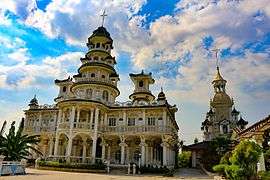
The St. Martin of Tours Church of Bocaue, otherwise known as The Diocesan Shrine of Bocaue, is one of the oldest churches in the province of Bulacan. The reputed Mahal na Krus ng Wawa (Beloved Holy Cross of Wawa) is kept here.
The Feast of the Holy Cross of Wawa is a festival held on the first Sunday of July, observed in honor of the Holy Cross of Wawa (Mahal na Krus sa Wawa), a relic believed to have saved the life of an old woman drowning in the Bocaue River. The main feature of this fiesta is what is called The Pagoda, a gaily-decorated structure riding on a huge bangka, which glides along the town river carrying people from all walks of life who would enjoy the ride while religious music is played and while feasting on sumptuous food.
Other religious populations in the town include those belonging to the Iglesia ni Cristo, Jehovah's Witness, Methodist, Aglipayan, Adventist, Baptist, and Mormons Christian sects. There are also a number of Evangelical, Pentecostal, Members Church of God International and Charismatic churches, ministries, fellowships, and groups in the municipality. The practice of Islam could also be found in the municipality.
Sports and Recreation
The Philippine Stadium, also known as the New Era University Stadium, is a sports stadium located inside the Ciudad de Victoria, a 75-hectare tourism enterprise zone located in the towns of Bocaue and Santa Maria, Bulacan. With a capacity of up to 25,000, it became the biggest stadium in the Philippines upon its completion.
The Philippine Arena, an indoor multi-purpose arena and the centerpiece of Ciudad de Victoria, is located just adjacent to the Philippine Stadium. With a seating capacity of 55,000 it became the largest indoor arena in the world upon its completion in 2014.
Education
Bocaue is also an education center for the Meycauayan, Marilao, Sta. Maria, and Balagtas municipalities area. The State-owned Bulacan Polytechnic College has a campus in Bocaue. Private Colleges and universities, such as St. Paul University-Bocaue Campus, Dr. Yanga's Colleges, and New Era University-Bocaue, can be found in the municipality. Several secondary schools, both public and private, can also be found in the Municipality.
Municipal Government
|
Sangguniang Bayan (2016–present) Mayor: Eleanor J. Villanueva-Tugna (Liberal)[10] Municipal Councilors:
|
|
Mayors of Bocaue
|
Vice Mayors of Bocaue
|
Gallery
- The Bocaue Toll Barrier of the NLEX.
- A part of the Gen. Douglas MacArthur Highway cutting across Barangay Lolomboy, Bocaue.
 View from the MacArthur Highway's Bocaue flyover.
View from the MacArthur Highway's Bocaue flyover..jpg) The Meralco Duhat Substation at Duhat, Bocaue.
The Meralco Duhat Substation at Duhat, Bocaue. A passenger tricycle crosses the Bocaue River Bridge.
A passenger tricycle crosses the Bocaue River Bridge. The now-unused Bocaue municipal water tower.
The now-unused Bocaue municipal water tower.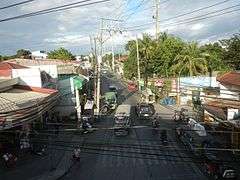 From the town's poblacion, Halili Road leads to Barangay Turo and the Bocaue exit to the NLEX.
From the town's poblacion, Halili Road leads to Barangay Turo and the Bocaue exit to the NLEX. Saint Peter of Alcantara Parish Church, Barangay Taal.
Saint Peter of Alcantara Parish Church, Barangay Taal.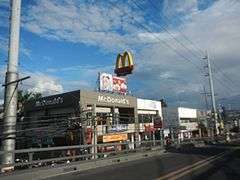 A view from the Bocaue flyover of the McDonald's restaurant in the town's poblacion.
A view from the Bocaue flyover of the McDonald's restaurant in the town's poblacion.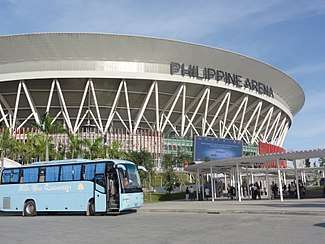 The Philippine Arena
The Philippine Arena.jpg) The Philippine Sports Stadium in Ciudad de Victoria, Bocaue.
The Philippine Sports Stadium in Ciudad de Victoria, Bocaue.
References
- ↑ https://m.facebook.com/story.php?story_fbid=2065191410192110&id=100001038133721
- ↑ "Municipality". Quezon City, Philippines: Department of the Interior and Local Government. Retrieved 31 May 2013.
- ↑ "Province: Bulacan". PSGC Interactive. Quezon City, Philippines: Philippine Statistics Authority. Retrieved 12 November 2016.
- 1 2 3 4 5 Census of Population (2015). "Region III (Central Luzon)". Total Population by Province, City, Municipality and Barangay. PSA. Retrieved 20 June 2016.
- ↑ ""Commission on Audit 2017 Report-Bulacan"". Quezon City, Philippines: Commission on Audit. Retrieved 8 July 2018.
- 1 2 Census of Population and Housing (2010). "Region III (Central Luzon)". Total Population by Province, City, Municipality and Barangay. NSO. Retrieved 29 June 2016.
- ↑ Censuses of Population (1903–2007). "Region III (Central Luzon)". Table 1. Population Enumerated in Various Censuses by Province/Highly Urbanized City: 1903 to 2007. NSO.
- ↑ "Province of Bulacan". Municipality Population Data. Local Water Utilities Administration Research Division. Retrieved 17 December 2016.
- ↑ "Aldub helps sales of firecrackers sour". Philippine Daily Inquirer. 29 December 2015. Retrieved 30 December 2015.
- ↑ "#PHVoteWatch: Luck to decide new Bocaue mayor". Rappler. 10 May 2016. Retrieved 10 May 2016.
External links
| Wikimedia Commons has media related to Bocaue, Bulacan. |
